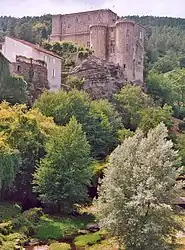Largentière
| |
|---|---|
Subprefecture and commune | |
 The castle in Largentière | |
.svg.png.webp) Coat of arms | |
Location of Largentière | |
 Largentière  Largentière | |
| Coordinates: 44°32′37″N 4°17′39″E / 44.5436°N 4.2942°E | |
| Country | France |
| Region | Auvergne-Rhône-Alpes |
| Department | Ardèche |
| Arrondissement | Largentière |
| Canton | Vallon-Pont-d'Arc |
| Government | |
| • Mayor (2020–2026) | Jean-Roger Durand[1] |
| Area 1 | 7.22 km2 (2.79 sq mi) |
| Population | 1,561 |
| • Density | 220/km2 (560/sq mi) |
| Time zone | UTC+01:00 (CET) |
| • Summer (DST) | UTC+02:00 (CEST) |
| INSEE/Postal code | 07132 /07710 |
| Elevation | 147–420 m (482–1,378 ft) |
| 1 French Land Register data, which excludes lakes, ponds, glaciers > 1 km2 (0.386 sq mi or 247 acres) and river estuaries. | |
Largentière (French: [laʁʒɑ̃tjɛʁ]; Occitan: L'Argentièira) is a subprefecture and commune of the Ardèche department in the Auvergne-Rhône-Alpes region in Southern France.
It is located in the narrow valley of the Ligne, approximately 10 km (6.2 mi) southwest of Aubenas. With a population of 1,573 as of 2020, Largentière is the second-least populated subprefecture in France after Castellane in Alpes-de-Haute-Provence.
Its name, adopted in the 13th century in place of its more ancient name Segualeriae (Ségualières), refers to the silver mines in the area between the 10th and 15th centuries, when the silver-bearing lead ores in intrusive veins in the Largentières sandstone[3] were exploited under the authority of the Counts of Toulouse and the Bishops of Viviers, whose title Barons de Largentière was linked to the bishopric.
Demographics
| Year | Pop. | ±% p.a. |
|---|---|---|
| 1968 | 2,888 | — |
| 1975 | 2,671 | −1.11% |
| 1982 | 2,373 | −1.68% |
| 1990 | 1,990 | −2.18% |
| 1999 | 1,942 | −0.27% |
| 2009 | 1,814 | −0.68% |
| 2014 | 1,734 | −0.90% |
| 2020 | 1,573 | −1.61% |
| Source: INSEE[4] | ||
Economy and transportation
A busy industrial town in the nineteenth century, when it housed silk mills[5] its principal industry is now tourism. Its only railroad station was rased in 1982, leaving the town accessible only by road.
Sights
Besides its twelfth- to fifteenth-century château, the town conserves its thirteenth-century church, Nôtre-Dame-des-Pommiers,[6] its Renaissance hôtel de ville, its palais de justice, and the Tour Argentière that collected the mines' produce for guarded transport.
Personalities
- Joseph ben Abba Mari ben Joseph ben Jacob Caspi (1279—1340), a prominent Jewish medieval philosopher.
See also
References
- ↑ "Répertoire national des élus: les maires". data.gouv.fr, Plateforme ouverte des données publiques françaises (in French). 2 December 2020.
- ↑ "Populations légales 2021". The National Institute of Statistics and Economic Studies. 28 December 2023.
- ↑ Guoxiang Chi, Pierre Rheaume, and Kees Schrijver, "The Largentière sandstone Pb-Zn-Ag deposit, Ardeche, France; fluid inclusion and geologic evidence for an epigenetic origin", Economic Geologyn92.1 (February 1997:108-113).
- ↑ Population en historique depuis 1968, INSEE
- ↑ Encyclopædia Britannica 1911.
- ↑ "Our Lady of the apple orchards"; an inscription of 1490 records the gift of the stone pulpit in Occitan: hieu Pierre Guarnier de Colens ay donat aquesta chadiera al convent.
External links